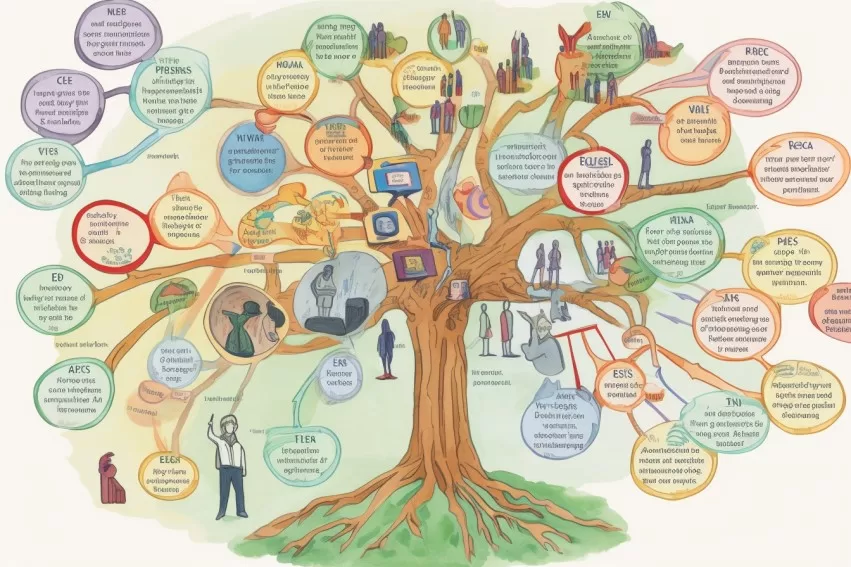Are you looking for ways to improve your problem-solving skills and make better decisions?
Mental models are powerful tools that can help you achieve that.
A mental model is a representation of how something works.
By understanding and mastering mental models, you can apply them to different situations and make better decisions.
In this article, we’ll explore what mental models are, the benefits they offer, and how to use them to problem-solve.
So let’s get started and see how mental models can help you become a better decision-maker.
What are Mental Models?

Thinking outside the box can really pay off, and understanding mental models is a great way to do that! A mental model is a “simplified representation of the world, which allows us to reason and make decisions”.
Mental models are based on fundamental principles, which can be used to better understand the underlying structure of the world, and the way it works. They are used to make decisions, analyze complex concepts, and identify cognitive biases. Mental models can also be used to improve decision-making and problem-solving skills.
Mental models are based on various techniques, such as mathematics, psychology, and philosophy. The core idea is to look at the world through a different lens, and to find patterns and connections between different concepts. This helps to identify underlying trends and patterns, which can be used to improve decision-making.
One of the most important aspects of mental modeling is the ability to recognize and address cognitive biases. By understanding the underlying principles of mental models, we can identify cognitive biases and make sound decisions. Furthermore, mental models can help identify trends and patterns that can be used to make better decisions in the future.
Mental models are an invaluable tool for anyone looking to make better decisions, solve problems more effectively, and improve their understanding of the world. By understanding the underlying principles of mental models, we can better understand the structure of our world, and use this knowledge to make better decisions and solve problems more effectively.
The Benefits of Mental Models

Unlocking the power of creative problem-solving can open up new possibilities for success! Mental models are powerful tools that help you think more effectively and efficiently. By understanding mental models, you can identify and avoid cognitive biases, develop better strategies for brainstorming, and use your emotional intelligence to make more informed decisions.
All of these benefits can help you make better decisions, solve problems faster, and even increase your chances of success. Mental models can help you identify and avoid cognitive bias. Cognitive bias is a form of systematic error in thinking that occurs when people make decisions that are not based on facts or reality. By using mental models, you can recognize these biases and make better decisions that are more in line with reality.
Brainstorming is a great way to come up with solutions to problems, but it can be difficult to keep track of all the ideas you have. Mental models can help you organize and prioritize your ideas, so you can focus on the best ones. This can help you get the most out of your brainstorming sessions and increase your chances of success.
Finally, mental models can help you hone your emotional intelligence. Emotional intelligence is the ability to understand and manage your own emotions and those of others. By using mental models, you can learn to recognize how your emotions are affecting your decisions and use that understanding to make better ones. This can help you become more successful in both your personal and professional life.
How to Identify Mental Models

Gaining an understanding of mental models can be a game-changer, giving you the ability to make decisions with confidence and clarity. Identifying mental models is the first step in this process, and it can be done by recognizing common patterns in our thinking.
For example, we often fall victim to constrained thinking, where we limit our choices to a few predetermined options. We also tend to seek out information that supports our existing beliefs, otherwise known as confirmation bias, and we can be reluctant to abandon investments of time or money, despite their being a sunk cost.
These common patterns of thought can be hard to recognize in ourselves, but with a little practice and self-awareness, we can begin to identify the mental models that we use. Once we become aware of the mental models we use, we can challenge them and ultimately improve our decision-making.
We can ask ourselves questions such as, “Am I thinking too narrowly?”, “Am I relying on confirmation bias to make this decision?”, and “Am I letting sunk costs influence my decision?”. We can also benefit from understanding the mental models of others.
By learning to recognize the mental models of others, we can better understand their thoughts and decisions. This can be invaluable in the workplace, where we must often interact with people who think differently from us. We can use this understanding to better collaborate and communicate with our colleagues.
Ultimately, developing an understanding of mental models can be a powerful tool for making better decisions and understanding the decisions of others. The more we understand our own thought processes, the better equipped we are to make well-informed decisions and to understand the decisions of those around us.
Problem-Solving with Mental Models

Using mental models to solve problems can help you make smarter decisions and understand others’ perspectives, giving you the power to revolutionize the way you approach life.
Brainstorming techniques are a great way to identify and identify solutions to problems. By taking the time to think of different possible scenarios and solutions, you can better understand the root of the problem and find the most effective solution.
This process of exploring the problem from different angles helps to de-bias decision making, as it allows you to consider a variety of options and perspectives. Cognitive biases are often obstacles to effective problem-solving.
Most people tend to make the same mistakes over and over again, regardless of the situation. By recognizing and understanding these biases, you can develop strategies for avoiding them. For example, if you know that you tend to make snap judgments, take the time to carefully consider all possible solutions before making a decision.
By taking the time to think through the problem, you can avoid falling into the same traps. Mental models can also help you to think more critically about the way you approach a problem.
By breaking down the problem into smaller chunks, you can better understand the underlying issue and come up with a more effective solution. For example, if you are trying to solve a complex problem, it might be helpful to look at it from different perspectives, such as the perspective of the people affected by the problem.
By doing so, you can gain a better understanding of the issue and come up with a better solution. No matter what type of problem you’re facing, using mental models can help you to think through it more effectively.
By understanding the underlying issues, considering various perspectives, and recognizing cognitive biases, you can make smarter decisions and come up with creative solutions. By understanding the power of mental models, you can use them to your advantage and take a more holistic approach to problem-solving.
The Ladder of Inference

Gaining an understanding of the Ladder of Inference will empower you to make more informed decisions and greater connections with those around you. The Ladder of Inference is a mental model that helps individuals better understand their own thinking process and how they come to certain conclusions.
It is composed of six steps, from observation to conclusion, that help us understand how our biases and assumptions can block us from reaching unbiased and informed decisions. This model encourages us to take a step back and consider the cause-effect relationships before jumping to conclusions.
The Ladder of Inference can also help us think more systemically, or holistically, instead of looking at one part of a problem. This model encourages us to consider the impact of our decisions on the greater system, as well as the value of considering multiple perspectives.
By analyzing each step of the ladder, we can identify our own biases and assumptions and make decisions that are more informed and unbiased. The Ladder of Inference is a powerful mental model that can help us think more critically and systematically.
It can help us identify our own biases and assumptions and recognize how they can lead us down the wrong path. It can also help us to consider the impact of our decisions on the larger system. Through the process of analyzing each step of the ladder, we can gain a better understanding of how our thinking processes work and how to make better decisions.
By understanding the Ladder of Inference, we can begin to examine our assumptions and biases more closely and make decisions that are more informed, unbiased, and beneficial for the greater system. This mental model can help us think more critically, make better decisions, and create deeper connections with those around us.
The 5 Whys Method

Discovering the 5 Whys Method can help you dive deeper into the root cause of any problem and identify creative solutions for it. The 5 Whys Method is a problem-solving technique developed by Toyota Motor Corporation to identify the root cause of a problem.
This method encourages you to ask ‘why’ five times to dig deeper into the cause of a problem. In doing so, it helps uncover the true cause of the problem and develop a better solution. The 5 Whys Method can help you identify and avoid cognitive biases that might be influencing your thinking, as well as help you to create an organized brain map of the issue.
When you use this method, it helps you to break free from preconceived notions and think outside the box. This method also encourages you to change your mindset and look at the problem from different angles. It can help you think of creative solutions that you might not have come up with on your own.
Furthermore, it can help you to anticipate potential problems and develop a plan to prevent them from occurring. The 5 Whys Method is an effective tool that can help you to identify and solve problems more efficiently. It encourages you to think deeply and use critical thinking to come up with solutions.
It can help you to uncover hidden assumptions and identify the true root cause of a problem. By using this method, you can develop better solutions and prevent future problems from occurring. The 5 Whys Method is a powerful tool that can help you to better identify and solve problems.
It encourages you to think deeply and challenge assumptions to come up with creative solutions. With practice, this method can help you to develop a deeper understanding of problems and create new solutions for them. It can help you to develop a growth mindset and broaden your perspective to think in new and innovative ways.
The Pareto Principle

By recognizing the power of the Pareto Principle, you can make sure you’re getting the most out of your resources and maximizing efficiency. The Pareto Principle, also known as the 80/20 rule, states that 80% of the effects come from 20% of the causes. This means that you should focus your efforts on the causes that are likely to bring about the most results.
| Cost Benefit Analysis | Stakeholder Analysis | Root Cause Analysis |
|---|---|---|
| Identify costs | Identify stakeholders | Identify root cause of problem |
| Analyze benefits | Analyze stakeholder needs | Analyze root cause to find solution |
| Compare costs/benefits | Prioritize stakeholder needs | Implement solution |
| Make decision | Implement solution | Test and monitor solution |
The Pareto Principle can be applied to many different areas, such as cost-benefit analysis, stakeholder analysis, and root cause analysis. Cost-benefit analysis helps you to identify the costs and the benefits of a certain decision, so you can make an informed decision. Stakeholder analysis helps you to identify who the stakeholders are and analyze their needs, so you can prioritize their needs. Root cause analysis helps you to identify the root cause of a problem and analyze it to find a solution.
The Pareto Principle is a powerful mental model for making decisions and maximizing efficiency. By using the Pareto Principle, you can make sure you’re getting the most out of your resources and investing your time and energy in the areas that are likely to bring about the best results. Applying the Pareto Principle to cost-benefit analysis, stakeholder analysis, and root cause analysis will help you to make better decisions and maximize your resources.
The SWOT Analysis

Gaining insight into your strengths, weaknesses, opportunities, and threats can help you make better decisions and maximize your potential. The SWOT Analysis (Strengths, Weaknesses, Opportunities, and Threats) is an invaluable tool to help you identify and understand the implications of your current situation. By analyzing your SWOT, you can gain a better understanding of the risks and advantages associated with your existing position. This can help you to create strategies that capitalize on your strengths and mitigate your weaknesses.
Using the SWOT Analysis can help you to spot potential opportunities and threats that you may not have considered. This is especially important for business owners, as they must make decisions that have far-reaching implications. By analyzing the SWOT of a business, you can gain a better understanding of the overall market and the competitive landscape. This can help you to develop strategies to gain an edge over your competitors and make better decisions about investments.
The SWOT Analysis is also a great tool for personal development. By recognizing your strengths and weaknesses, you can make more informed decisions about your career, education, and relationships. You can also use the SWOT Analysis to identify potential opportunities that you may not have considered. This can help you to take advantage of new opportunities and create strategies to achieve your goals.
The SWOT Analysis is a powerful tool that can help you gain insight into your current situation and make better decisions. By recognizing your strengths and weaknesses, you can identify potential opportunities and threats and create strategies that maximize your potential. Understanding the implications of your current position can help you make informed decisions that will have a positive impact on your future.
The OODA Loop

Understanding the OODA Loop can help you make quick, informed decisions that can give you an edge over your competition. The OODA Loop is a mental model created by US Air Force Colonel, John Boyd, to explain how individuals and organizations can gain a first mover advantage in decision-making.
This loop consists of four steps: Observation, Orientation, Decision, and Action. Each step builds on the previous one, allowing you to quickly process information and act on it.
In the Observation step, you take in information from your environment and look for patterns and trends. As you observe, you must remain aware of your cognitive biases and mental shortcuts that could lead to faulty conclusions.
In the Orientation step, you analyze the information you’ve gathered and develop a mental map to identify potential opportunities or threats. The Decision step is where you decide which action to take based on the information you’ve gathered and analyzed.
Finally, in the Action step, you execute the decision you made in the previous step. The OODA Loop is a useful tool for making decisions in uncertain environments. It helps you to quickly process information and make decisions based on the best available evidence.
This mental model can also help you identify potential opportunities or threats before your competition does, giving you a first mover advantage. Additionally, by understanding and using the OODA Loop, you can reduce the impact of cognitive biases and mental shortcuts.
By recognizing the importance of the OODA Loop and how it can help you outmaneuver your competition, you’ll be better equipped with the tools necessary to make quick, informed decisions. Instead of relying on mental shortcuts or cognitive biases, you’ll be able to use the OODA Loop to observe and orient yourself in any situation. This will give you the advantage of being able to make decisions faster and with greater accuracy.
Frequently Asked Questions
How do mental models help me think more clearly?
Mental models are powerful tools that can help you think more clearly and be more disciplined in your cognitive reasoning. By integrating models and recognizing cognitive biases, you can challenge yourself to think deeper and identify potential flaws in your logic.
Mental models provide a framework to help you break down complex problems into smaller, more manageable pieces. With practice, you can develop mental discipline and become more adept at solving difficult problems.
With mental models, you can gain a deeper understanding of the world and develop the skills necessary to become a master of your craft.
What strategies can I use to remember mental models?
Developing an understanding of mental models is essential to becoming a better thinker. To remember them, focus on recognizing patterns, building connections, and exploring analogies.
Ask yourself questions like: what similarities or differences can I identify between two models? How do the models interact with each other?
By taking the time to answer these questions, you’ll be able to gain a deeper understanding of each model and how they work together. By committing mental models to memory, you’ll be able to improve your thinking, decision making, and problem-solving skills.
How can I apply mental models to my daily life?
You can apply mental models to your daily life by understanding your biases, recognizing your assumptions, and questioning your beliefs. Mental models help us make better decisions by allowing us to see the world from different perspectives.
By taking the time to understand our own biases and recognizing our assumptions, we can become more aware of our thoughts and how they shape our day-to-day actions. Additionally, questioning our beliefs helps to keep our minds open, allowing us to more easily identify our blind spots and expand our knowledge.
By using mental models in our daily life, we can become empowered to make more informed choices and lead lives of mastery.
How can I use mental models to make decisions?
Making decisions can be difficult, but using mental models can help. Mental models are based on recognizing patterns, using biases, and planning ahead.
By recognizing patterns in past experiences, you can make better decisions in the future. You can also use biases to help you make more informed decisions, such as the confirmation bias and the status quo bias.
Additionally, planning ahead can help you anticipate potential outcomes and make decisions accordingly. Taking the time to understand mental models and how you can use them to make decisions can help you make better decisions in the long run.
How can I use mental models to become more successful?
You can use mental models to become more successful by developing habits, managing your time effectively, and reflecting on your actions.
Habits can help you stay focused on the task at hand, freeing up more time to do other activities.
Time management can help you prioritize important tasks, and use your time more efficiently.
Finally, self-reflection can help you identify areas of improvement, and make necessary changes to become more successful.
With mental models, you can become a master of your own destiny.
Conclusion
You’ve learned what mental models are, the benefits of using them, how to identify them, and how to use them for problem-solving.
You’ve also seen examples of mental models you can use in your everyday life.
Mental models are powerful tools that can help you make better decisions and think more strategically.
They can help you break down complex problems and see them from different angles.
So take a few moments to identify the mental models that you can use to make better decisions and tackle difficult problems.
It’ll be worth the effort.

